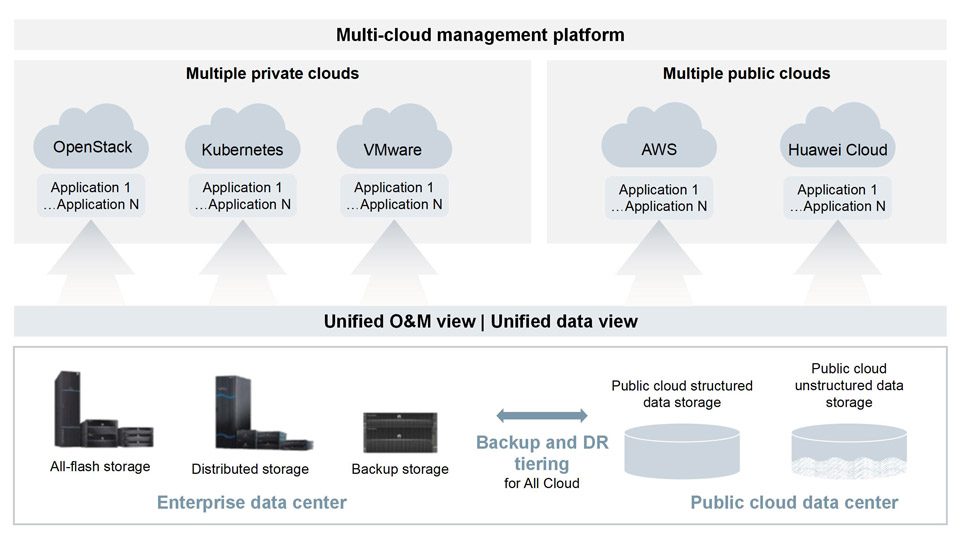New Solutions
Embracing the Multi-cloud Era with Reliable Data Storage Infrastructure
Today's enterprises need to develop IT systems based on multiple public and private clouds underpinned by reliable data storage infrastructure.


By Peter Zhou, President, IT Product Line, Huawei

The evolution of civilization has always gone hand in hand with recording and spreading information. From tying knots in strings to bone script, from paper to hard disks and flash memory, the methods of recording information have seen enormous leaps throughout history.
Today, civilization uses digital storage to retain data. The data storage industry has been evolving alongside the development of data applications. Early on, databases were simply data applications, and the earliest IBM mainframes primarily ran database systems. Redundant arrays of independent disks (RAID) technology connects disks together as disk arrays, and it was with this technology that EMC launched the world's first specialized storage device in 1991. This device marked the upgrade of mainframe architecture from separated computing and storage to integrated computing and storage, and was the origin of the storage area network (SAN) architecture.

Around the year 2000, the emergence of the Internet paved the way for network-attached storage (NAS), making highly reliable storage and the efficient sharing of document data possible. Then, around 2010, the emergence of cloud computing represented by virtual machines led to the popularization of unified storage that integrates SAN and NAS. In 2015, all-flash storage started replacing hard disk drive (HDD) storage at scale, delivering advantages in performance, reliability, and energy efficiency. Moreover, emerging applications based on massive amounts of unstructured data, such as video, big data, and AI, gave rise to scalable distributed storage.
Two drivers of the storage industry's future growth
Driver 1: New demand for applications, data, and security
The digital transformation of industries is approaching a critical stage of rapid growth, and new demand for applications, data, and security is driving continuous innovation and development throughout the data storage industry.
This demand is impacting the storage industry in three key ways:
First, data-based applications are quickly emerging. In addition to conventional database service applications, new applications in areas like virtualization, containers, big data, and AI have emerged. Furthermore, requirements for data reliability are becoming increasingly prominent. The widening gap between the lifecycle management of computing and data means there is a growing need to flexibly and separately plan and maintain computing and storage resources. The adoption of decoupled storage-compute architecture and specialized storage solutions that are elastic, reliable, and cost-effective can ensure the quick deployment of innovative services that offer higher reliability, lower costs, and greater profitability.
Second, unstructured data is becoming widely used across enterprises as a key factor in production decision-making, with 56% of enterprises now using AI to analyze and process unstructured data. With enterprises' improving their data governance capabilities, data-driven service growth is becoming increasingly possible. Efficient and reliable distributed storage solutions designed for massive amounts of unstructured data are now the foundation for enterprise data governance.
Third, frequent data security incidents are resulting in huge economic losses, making the improvement of digital resilience a priority for enterprises. In recent years, the main focus of data security protection has expanded from damage caused by physical factors to those caused by humans. Statistics show that in 2021, the average cost of recovering enterprise data from ransomware attacks totaled a staggering US$1.85 million. Following a ransomware intrusion, the affected network loses the ability to prevent ransomware from damaging data. This is where storage solutions can be an invaluable last resort in data protection, thanks to ransomware detection, secure snapshot, data isolation, and data recovery capabilities.
Driver 2: Common adoption of multi-cloud access
With more enterprises becoming cloud-based, cloud-native technologies like containers are gaining traction. Storage solutions are required to support container-based application resource provisioning and disaster recovery (DR) and backup. Statistics show that 89% of enterprises around the world have already formulated a multi-cloud strategy to leverage the strengths of multiple cloud platforms. However, the multi-cloud model typically results in cloud data silos, making it incredibly difficult to share data across multi-cloud applications. Moreover, due to the differences in services between cloud platforms, interoperability between ecosystems is practically impossible.
Some enterprises have adopted an IT architecture that features centralized data sharing and multi-cloud application deployment as a way to address these challenges, maximizing both data resource sharing and circulation.
Additionally, many enterprises have chosen to deploy different types of applications and data in either their data centers or public clouds, depending on application types and data security requirements. This enables unified cross-cloud data management and effective data flow, maximizing data storage and management efficiency. Storage solution providers across the industry are also using integrated hardware-software or software-only approaches to deploy specialized storage solutions that are already widely used in data centers on public cloud platforms, realizing the smooth cross-cloud evolution of enterprise data storage.

Huawei Data Storage builds reliable multi-cloud-era data infrastructure for industries
Over the past few years, Huawei's OceanStor Dorado All-flash Storage solution has earned the trust of many customers thanks to its high performance, stability, and reliability. For example, in the financial industry, more than 40 of the world's top 100 banks have chosen Huawei. Today, Huawei's data storage portfolio is building reliable data infrastructure of the multi-cloud era for enterprises across more industries.
These products boast the following features:
First, full coverage, from data center solutions to enterprise branch solutions. Huawei provides a full range of data storage solutions, including high-performance OceanStor Dorado all-flash solutions, OceanStor Pacific distributed storage for massive amounts of unstructured data, OceanProtect dedicated backup storage, and FusionCube hyper-converged infrastructure.
Second, structured data to unstructured data storage. Building on its leadership in SAN, Huawei Data Storage has gone all out on NAS file applications. In addition, Huawei's latest OceanStor Pacific distributed storage system is the only product in the industry that supports mixed loads to support diverse applications including high performance data analytics (HPDA), big data, video, backup, and archiving.
Third, data storage to intelligent O&M. The automation of O&M based on a data management engine (DME) frees O&M personnel from tedious, routine work so that they can focus on more creative tasks.
Fourth, data protection to data security. Huawei Data Storage provides comprehensive anti-ransomware storage solutions that range from primary storage to backup storage. These solutions employ a self-developed and proprietary ransomware detection engine based on machine learning algorithms to analyze data read/write behavior and file damage, realizing up to 99.9% ransomware identification accuracy.
Embracing the multi-cloud era in four key areas
To address diverse data application scenarios in the future, Huawei Data Storage will embrace multi-cloud technology in four focus areas. We will integrate enterprise-level storage capabilities within enterprise private and public clouds to build reliable multi-cloud-era data infrastructure for customers. This infrastructure will feature global sharing and consistent capabilities both on and off the cloud.
Area 1: Building unified data infrastructure for multi-cloud access to enable free cross-cloud data flow
Huawei Data Storage consolidates diverse storage devices within a unified resource pool and supports open, standardized interface protocols to connect and integrate storage and multiple clouds. This enables a cross-cloud and cross-data-center global storage resource pool that maximizes data sharing and circulation.
The key to data flow is that data can be classified into hot and cold data within an enterprise data center, and also that data can also be easily transferred and backed up by this classification between an on-premises data center and public cloud. Huawei Data Storage intelligently distinguishes hot, warm, and cold data, and enables on-demand data flow between local production storage, backup, and archive storage, and cloud.
The storage of different data in different media minimizes the total cost of ownership (TCO).
Area 2: Building cross-cloud data sharing capabilities for unified data views and scheduling
With the adoption of a multi-cloud model by enterprises, data is distributed across different cloud platforms. Differences between cloud service providers in terms of APIs, data exchange standards, and technologies impede interoperability between ecosystems and data invocation across clouds, making data sharing difficult and costly.
Area 3: Building container storage capabilities to enable cloud-based data center applications
To address the requirements for more agile and elastic applications, enterprises must containerize traditional applications and migrate cloud-native application ecosystems to on-premises data centers. Therefore, enterprises need to upgrade their data infrastructure to better support container technology.
Huawei Data Storage provides the Container Storage Interface (CSI) plug-in that is compatible with a wide range of mainstream container cloud platforms. This allows enterprises to use Huawei storage solutions to provide persistent storage resources that feature high performance, high reliability, and on-demand configuration, with 30% higher resource provisioning efficiency than the industry average.
Huawei also provides the Container Disaster Recover (CDR) plug-in, which provides application-level, cross-cloud, and cross-data-center disaster recovery (DR) for containers. This gives key cloud-native applications the same DR capabilities as traditional applications and improves data security and reliability for containerized service applications.
Area 4: Building a diskless data-center architecture to overcome challenges in efficient and massive data storage across clouds
When dealing with the surge in the amount of data, cloud and Internet enterprises traditionally use an integrated server architecture for storage that couples applications and local disks. This storage-computing integrated architecture causes issues like resource waste, poor reliability and storage efficiency, and limited scaling elasticity, impeding the full use of computing power.
Designed for diskless server architecture, Huawei's OceanDisk Smart Disk Enclosure can replace local server disks with diskless servers and a remote storage pool, so that computing and storage resources can scale independently and elastically. OceanDisk also connects the remote disk pool to servers through high-speed NoF+ Ethernet, realizing high-performance storage comparable to local disks. In addition, OceanDisk employs multiple technologies, such as data reduction and disk sub-health management, which reduces costs; simplifies O&M; and enables greener, more powerful, and more reliable cloud and Internet data centers.
Over the past three decades, data storage has served as a solid foundation for high-value data, evolving side-by-side with data applications. Now, as we usher in the yottabyte (1024 bytes) data era, in which data applications will boom, Huawei Data Storage is embracing the multi-cloud era and working alongside storage customers and partners worldwide to forge a bright future for the data storage industry.
- Tags:
- Data Storage





